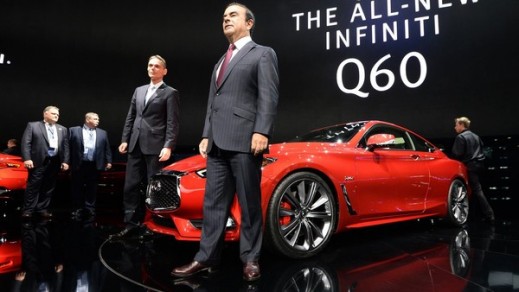John Bukowicz, Managing Director for the Americas, LIASE Group; Vanessa Moriel, Managing Director Asia, LIASE Group; and Vic H. Doolan, Non-Executive Member of the Board, LIASE Group attended the 2016 edition of the Consumer Electronics Show in Las Vegas January 6-9 followed by the North American International Automotive Show and the Automotive News World Congress in Detroit January 11-15. With the rise of CES as a major automotive show and the continued importance of Detroit as North America’s largest car show, LIASE group benefitted from both events to mingle and network with global automotive executives, leaders and disruptors.
CES has become the top destination for car companies to unveil their latest tech and gadget; and for car lovers and automotive leaders to see what new products will be reaching the market in the coming months and years. The 2016 edition was no different as automakers and tech suppliers once again stole the spotlight in Las Vegas.
Autonomous driving took center stage at CES, but other more mature technology was also on display. Driving personalization through cloud connectivity and smart mobility stood out as particularly interesting.
Mercedes-Benz, which had unveiled the stunning F015 Concept at CES 2015 took a bold step and unveiled a production model vehicle for the first time ever at the Las Vegas show. The 2017 E-Class will have fully autonomous technology when it hits the road next year. Mercedes also unveiled its ME concept, using predictive data to know the driver’s daily routine.
Toyota had announced a US $ 1 billion advanced AI and robotic program to make cars safer and smarter and develop home robots to help people earlier in 2015. Toyota Research Institute CEO Gill Pratt announced an impressive line-up of engineers and executives. Among these senior hires are James Kuffner, who recently headed Google’s robotic program and will work on cloud computing with Toyota. Notable advisers include Rodney Brooks from Rethink Robotics and Marc Benioff from Salesforce.
Toyota also made a splash with its FCV Plus concept that generates electricity from a hydrogen fuel cell. The fuel cell not only powers the car, but can also be used to power a house as well. And Toyota also unveiled its Toyota Agent+, which used machine learning to predict the driver’s likely destination.
Ford CEO Mark Fields unveiled a partnership with Amazon. This will link Ford’s Sync 3 infotainment system to connect with Amazon’s Echo voice command device. Ford owners will be able to use voice commands to start the car or open a garage door. Ford also unveiled a vehicle-to-drone communication system that will initially be used in disaster relief but could eventually develop into wider commercial use.
GM’s Chevrolet premiered the 2017 Bolt EV, which garnered high praises for its massive range, interior space and competitive price, at about $US 30,000 in the US. Until Tesla unveils its model 3, industry insiders seem to agree that the new Bolt will be the EV model to beat. GM also unveiled a $500 million partnership with Lyft the day before CES started.
Volkswagen unveiled an electrified version of its popular camper van. The BUDD-e Concept will be configured like Tesla’s Model S, with motors in the front and back, and a battery pack in the middle and boasts. The BUDD-e comes with the usual array of gadgetry, touchscreens, and voice command activated features.
Korean automaker Kia showed its Drive Wise autonomous driving technology and sub-brand. The system uses a combination of radar, camera, GPS and ultrasonic sensors to drive on the highway or in the city without driver involvement. It said it planned to invest $2 billion into self-driving car technology before 2018. Kia also unveiled the I-Cockpit concept, previewing the carmakers future in-car technology.
Suppliers also made major announcements at the show.
- Chipmaker Nvidia release its Drive PX 2 self-driving computer which controls self-driving vehicles through 12 CPU cores.
- Leading camera supplier Mobileye announced deals with GM and Volkswagen to supply mapping data for their autonomous driving programs.
- Meanwhile, their competitors, Here, which was purchased by a German consortium of automakers made up of Audi, BMW and Mercedes-Benz showed off its HD Live Map platform for self-driving cars.
- Blackberry’s infotainment division, QNX, introduced its platform for autonomous cars, ADAS. The product will allow carmakers to build automated driving system with 360-degree surround view that integrate information from multiple sources including radar, cameras, and high-performance processors that control fully autonomous vehicles.
- Delphi talked about V2E, which it says stands for “vehicle to everything” communication. The concept encompasses vehicle-to-vehicle, vehicle-to infrastructure and vehicle-to-smartphone communication.
- Bosch showed technology connecting the car to the home, adjusting the lighting and temperature of the home once it detects the car approaching. It also showcased how images from the home can be seen from the car.
- Harman showed several advances in its in-car technology. First was the Harman Advanced Navigation system, which uses crowdsourced traffic, parking and hazard information to make trips as stress-free as possible. It also showed how its acquisition of TowerSec security company could protect cars from hackers , announced a partnership with Microsoft to port Office 360 and Skype conversations on dashboards, and unveiled eye detection technology that can measure driver drowsiness.
Detroit Auto Show
Now in its 28th year, the Detroit Auto Show taking place January 11-24 at the COBO Center in Detroit remains most important annual showcase for US carmaker.
While executives in Las Vegas celebrated high-end EV vehicles like Chevrolet’s Bolt and autonomous driving technology, back in Detroit, low fuel prices and surging sales figures meant that large pick-up trucks and SUVs were on full display.
The new SUVs and pick-ups on display in Detroit are designed to boost profits and help fund the massive R&D investments necessary to improve fuel efficiency and keep up with technology giants such as Google and Apple in the race to create driverless cars.
This is also what’s behind the surge in luxury vehicles. Ford unveiled a new Continental saloon and Hyundai launched a new luxury brand with the unveiling of its Genesis G90 luxury model. Meanwhile, Volvo launched the new S90 sedan and Nissan unveiled the latest version of the Q60 sports sedan. Lexus showed off its LC 500, a new flagship sports coupe, along with a hydrogen-powered concept, the LF-FC. Buick surprised many commenters by unveiling a beautiful Avenir Concept for its future flagship. Some even worry that the luxury car market could be reaching saturation.
In terms of pickups, Honda reveled its new Ridgeline truck. Nissan unveiled a beefy Titan Warrior Concept truck. And Kia, known for small affordable cars, unveiled a full-size pickup concept.
Meanwhile, Chrysler updated its Town and Country line with the Pacifica. The minivan features a number of features and comes as a plug-in hybrid.
GMC also made a bang with the debut of its seven to eight passenger crossover Acadia model. The new model is more than 20 centimeters shorter than the old one.
But the high-tech ways of Las Vegas also had reverberations in Detroit. Toyota’s main presentation focused on a new satellite antenna which will be capable of downloading massive amounts of data, and essential update for the coming era of connected and autonomous vehicles.
The government also had an unusually high profile at the show this year.
Obama visited the Detroit Auto Show for the first time in his presidency. Obama stopped at the exhibits of Fiat Chrysler, Ford and German supplier ZF. The President also praised the new Chevy Bolt, saying he planned to buy one once he had left office.
The U.S. Department of Transportation Secretary Anthony Foxx announced a $4 billion request to set up a nationwide connected car network. In the process also announcing a willingness to revise federal rules to develop high-end safety technology in the country.
Automotive New World Congress
The Detroit Auto Show press days were followed by the Automotive News World Congress, one of the world’s most prestigious automotive conference. This year’s event was featured the following speakers amongst others:
- Donna Satterfield, Vice President, Americas Automotive, Aerospace & Defense, IBM
- Mike Jackson, Chairman, CEO and President, Autonation
- Don Walker, Chief Executive Officer, Magna International
- Dan Ammann, President, General Motors
- John Krafcik, CEO, SelfDriving Car Project, Google
- Jim Lentz, Chief Executive Officer, Toyota North America
- Carlos Ghosn, President and CEO, RenaultNissan Alliance
- Rick Hanna, Global Automotive Leader, PwC
- Scott Keogh, President, Audi of America
- Andrew Brenner, Product Manager, Android Auto, Google
- Jeff Klei, President, NAFTA Region, Continental Corporation
- Danny Shapiro, Senior Director of Automotive, NVIDIA
- Janet Barnard, President, Manheim North America
- Ludwig Willisch, President and CEO, BMW of North America LLC
- Harry Wilson, Chairman & CEO, MAEVA Group LLC
- Mark Fields, President and Chief Executive Officer, Ford Motor
The two week trip closed off with the annual NAIAS black tie gala which LIASE Group gladly attended.
2016 Consumer Electronics Show
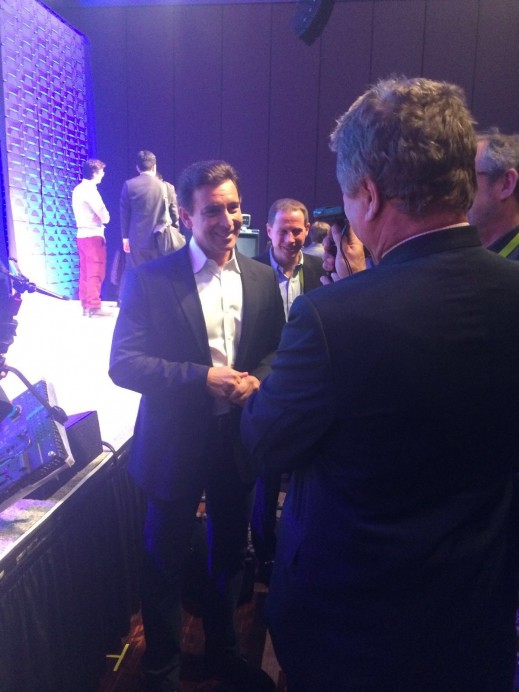
Ford Motor Company President and CEO Mark Fields talking with industry people at the 2016 edition of CES after finishing his keynote press conference at CES.

LIASE Group Managing Director Asia, Vanessa Moriel, posing together with Joe Vitale, Principle, Deloitte Consulting.
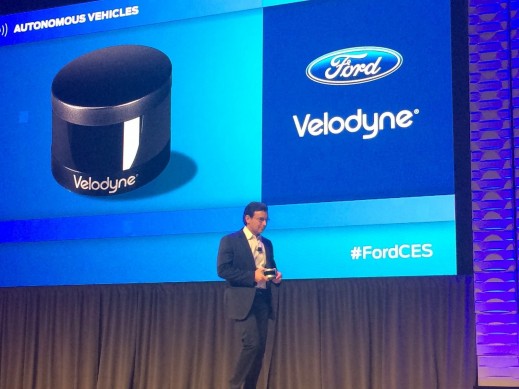
Ford CEO Mark Fields talking about the new Velodyne Puck sensor during his press conference in Las Vegas. Velodyne Lidar devices help autonomous cars scan the road ahead and plot a safe course.

Ford also announced it is investing in technology to launch droned from its vehicles. The applications that were cited were for first responders in disaster zones, but its uses could eventually be expanded.

The Volkswagen BUDD-e Concept is an all-electric concept minivan inspired by the 1970s VW camper vans.

The interior of the new Mercedes-Benz E-Class unveiled at CES 2016 feature “touch-sensitive” controls on the steering wheel.
2016 Detroit Auto Show

Vanessa and John pose in front of the Verizon IndyCar Series display with Juan Pablo Montoya’s 2015 Indianapolis 500-winning car.
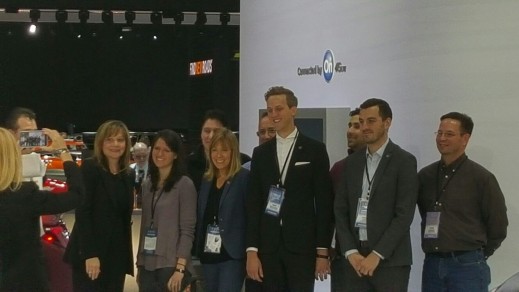
General Motors Company Chairman and CEO Marry Berra (left) posing for a picture at the Detroit auto show while touring the show on press day.
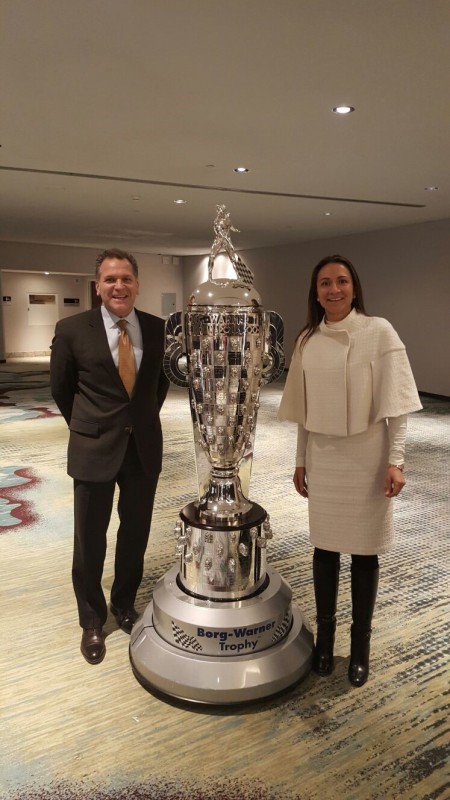
LIASE Group’s John Bukowicz, Managing Director for the Americas and Vanessa Moriel, Managing Director Asia posing together with the Borg-Warner Trophy, which is presented every year to the winner of the Indy 500 race.

Vanessa Moriel, Managing Director Asia, Liase Group posing with the Winner of the Indy 500 Race, Colombian racer Denny Hamlin.

Vic H. Doolan, Non-Executive Member of the Board, LIASE Group, posing with Keith Crain, Founder, Crain Communications Inc.

Left to right: Vic H. Doolan, Non-Executive Member of the Board, LIASE Group; Vanessa Moriel, Managing Director Asia, Liase Group; and, John Bukowicz, Managing Director for the Americas, LIASE Group, pose in front of new the new Genesis G90 luxury car by Hyundai.

Vanessa Moriel, Managing Director Asia, Liase Group and John Bukowicz, Managing Director for the Americas, LIASE Group stand next to Volvo’s new S90.

Vanessa Moriel, Managing Director Asia, Liase Group poses with Jack Cheng, CEO, Nextev and Cynthia Lin, Assistant of Foreign Affairs, CCPIT Automotive Committee.
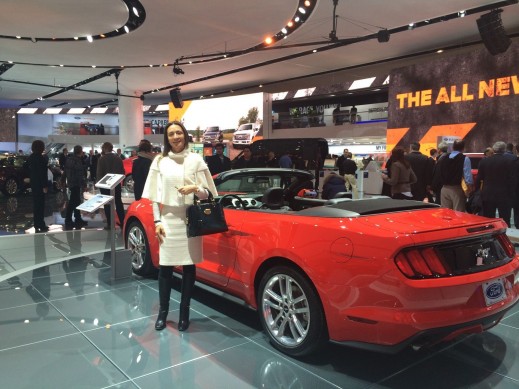
Vanessa Moriel, Managing Director Asia, Liase Group poses for a picture next to a convertible Ford Mustang.

Left to right: John Bukowicz, Managing Director for the Americas, LIASE Group; Vanessa Moriel, Managing Director Asia, Liase Group pose with North America Executives from Autoliv and Panasonic.

Left to right: John Bukowicz, Managing Director for the Americas, LIASE Group Vanessa Moriel, Managing Director Asia, Liase Group; John Lauri, Director, Siren of Chrome, and the movie’s main actress Rachel.

John Bukowicz, Managing Director for the Americas, LIASE Group (left); a TV presenter (center) and Vanessa Moriel, Managing Director Asia, LIASE Group pose during the black tie gala at the Detroit Auto Show.

John Bukowicz, Managing Director for the Americas, LIASE Group, and Vanessa Moriel, Managing Director Asia, LIASE Group, pose with Thomas Heringer from Automobilwoche.

There were more than13,000 attendees at the 2016 North American International Auto Show’s 40th annual Charity Preview at Cobo Center. Guests were able to mingle on the showroom floor and get a first look at 750 vehicles before the public opening.

Volvo Cars Corporation CEO Hakan Samuelsson at the Detroit Auto Show. Volvo unveiled the new S90 that will compete with Mercedes’s E-Class and BMW’s 5 series.

Bill Fords, Executive Chairman, Ford Motor Company and Mark Field, CEO, Ford Motor Company, posing together following Ford’s press conference in Detroit.
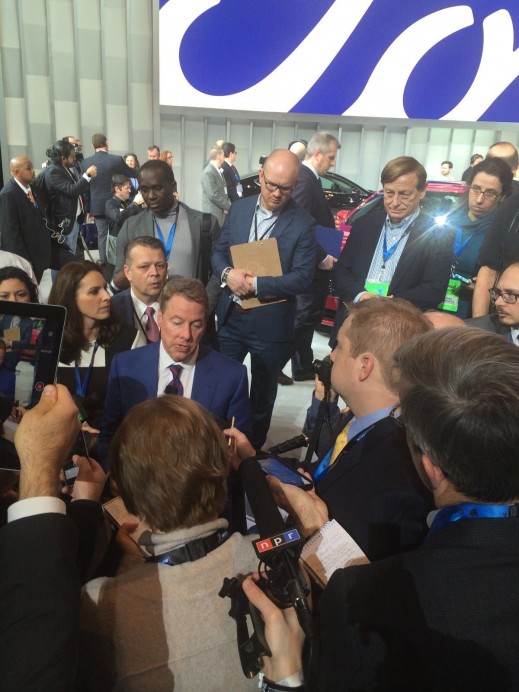
Bill Fords, Executive Chairman, Ford Motor Company, in the middle of a press scrum at the Detroit Auto Show.













